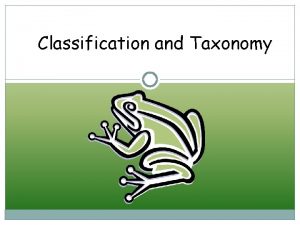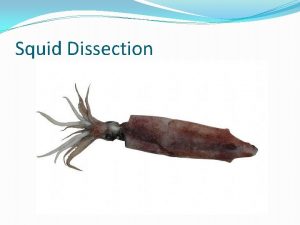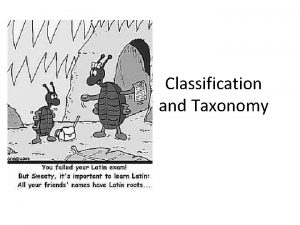Classification Taxonomy The rules for identifying and classifying











- Slides: 11


Classification • Taxonomy: – The rules for identifying and classifying organisms – Hierarchical levels (taxa) based on hypothesized evolutionary relationships – Levels are, from least inclusive to most inclusive: • Species, genus, family, order, class, phylum, kingdom, and domain • A level usually includes more species than the level below it, and fewer species than the one above it Biology, Sixth Edition Chapter 1, A

The Diversity of Organisms • Currently estimated that 1. 75 million species exist on Earth • The study of systems of classification is called taxonomy; carried out by taxonomists • The method of Linneaus is called the binomial nomenclature system because a combination of two names, genus and species, uniquely identifies each organism • The specific epithet (species name) usually describes something about the organism • Both genus and species are italicized; genus capitalized, species lowercase Biology, Sixth Edition Chapter 1, A

The Linnaean Classification System: A Binomial Scheme Domestic cat Human White oak tree Kingdom Animalia Plantae Phylum Chordata Anthophyta Subphylum Vertebrata Class Mammalia Order Family Genus Species Biology, Sixth Edition Chapter 1, A Dicotyledones Carnivora Felidae Primates Hominidae Fagales Fagaceae Felis catus Homo sapiens Quercus alba

Learning Objective 6 What are the 3 domains and 6 kingdoms of living organisms? Biology, Sixth Edition Chapter 1, A

Three Domains • Bacteria • Archaea • Eukarya Biology, Sixth Edition Chapter 1, A

Six Kingdoms • • • Biology, Sixth Edition Chapter 1, A Archaea Bacteria Protista Plantae Fungi Animalia

3 Domains of life Six Kingdoms : Two are Prokaryotic The prokaryotes (which are primarily distinguished from eukaryotes by NOT having a nucleus) form two domains that are also two kingdoms. The differences between these groups are as great as the differences between the bacteria and eukaryotes. Domain Archaea The Archaebacteria: – Ancient-type bacteria that thrive in heat, salt, acid conditions, and process methane (so-called methanogens) Domain Eubacteria The Eubacteria: – ‘Modern’ anaerobic and aerobic bacteria that live in soil, on other organisms, on surfaces, in the sea, and in many other places Biology, Sixth Edition Chapter 1, A

Domain Eukarya The Eukaryotes, which have a nucleus, form a third domain, and comprise 4 additional kingdoms: • Protista – Eukaryotic unicells: protozoa, algae, water molds, slime molds • Fungi – Yeasts, mildew, molds, and mushrooms – Nonphotosynthetic: heterotrophs • Plantae – Complex organization – Nonvascular (mosses) and vascular (ferns, conifers, flowering) plants – Many photosynthetic, make carbohydrate from H 2 O & CO 2 – Stiff outer cuticle with cell walls • Animalia – Multicellular heterotrophs – Complex tissues and organs, capacity for movement Biology, Sixth Edition Chapter 1, A

Tree of Life Biology, Sixth Edition Chapter 1, A

Memory trick • How to remember the order for classification: – – – – Domain Kingdom Phylum Class Order Family Genus Specie Biology, Sixth Edition Chapter 1, A Darn King Phillip came over for good sports





















